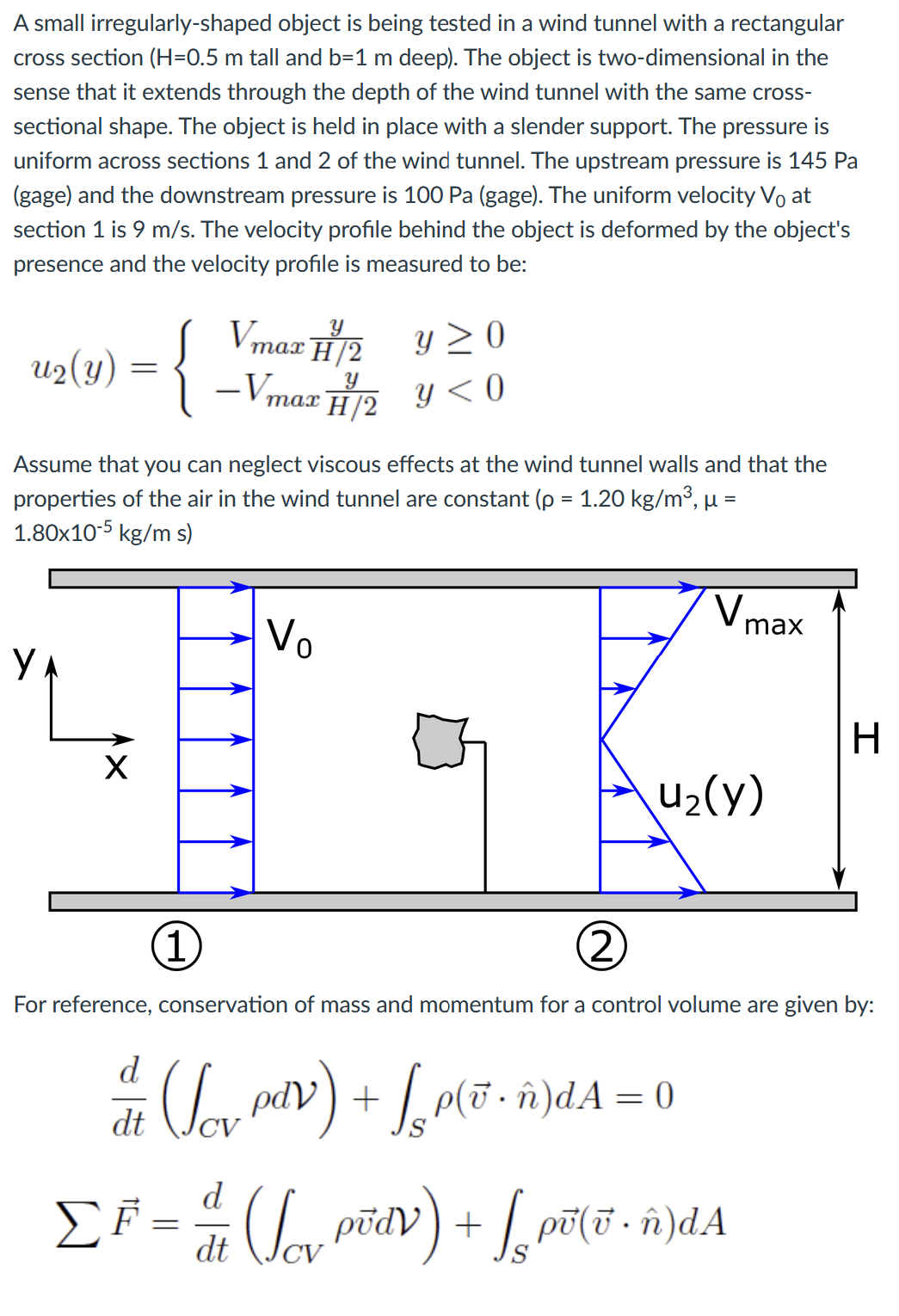A small irregularly-shaped object is being tested in a wind tunnel with a rectangular cross section (H=0.5 m tall and b=1 m deep). The object is two-dimensional in the sense that it extends through the depth of the wind tunnel with the same cross- sectional shape. The object is held in place with a slender support. The pressure is uniform across sections 1 and 2 of the wind tunnel. The upstream pressure is 145 Pa (gage) and the downstream pressure is 100 Pa (gage). The uniform velocity Vo at section 1 is 9 m/s. The velocity profile behind the object is deformed by the object's presence and the velocity profile is measured to be: U2 (Y) = { Assume that you can neglect viscous effects at the wind tunnel walls and that the properties of the air in the wind tunnel are constant (p = 1.20 kg/m³, µ = 1.80x10-5 kg/m s) Y X Y Y≥0 Vmax H/2 -Vmax H/2y<0 1 Vo V₁ u₂(y) d (₁₂ pav) + [₂p(ï ñ)dA=0 (Lov • dt max (2) For reference, conservation of mass and momentum for a control volume are given by: d ΣF = 1 / (√₁₂ põdv) + [₂ põ(v - ñ)dA ΣΕ dt H
A small irregularly-shaped object is being tested in a wind tunnel with a rectangular cross section (H=0.5 m tall and b=1 m deep). The object is two-dimensional in the sense that it extends through the depth of the wind tunnel with the same cross- sectional shape. The object is held in place with a slender support. The pressure is uniform across sections 1 and 2 of the wind tunnel. The upstream pressure is 145 Pa (gage) and the downstream pressure is 100 Pa (gage). The uniform velocity Vo at section 1 is 9 m/s. The velocity profile behind the object is deformed by the object's presence and the velocity profile is measured to be: U2 (Y) = { Assume that you can neglect viscous effects at the wind tunnel walls and that the properties of the air in the wind tunnel are constant (p = 1.20 kg/m³, µ = 1.80x10-5 kg/m s) Y X Y Y≥0 Vmax H/2 -Vmax H/2y<0 1 Vo V₁ u₂(y) d (₁₂ pav) + [₂p(ï ñ)dA=0 (Lov • dt max (2) For reference, conservation of mass and momentum for a control volume are given by: d ΣF = 1 / (√₁₂ põdv) + [₂ põ(v - ñ)dA ΣΕ dt H
Elements Of Electromagnetics
7th Edition
ISBN:9780190698614
Author:Sadiku, Matthew N. O.
Publisher:Sadiku, Matthew N. O.
ChapterMA: Math Assessment
Section: Chapter Questions
Problem 1.1MA
Related questions
Question
Please sketch an appropriate control volume in relation to the wind tunnel. Identify all forces acting on the control volume that you draw.
a) Determine the mass flow rate through the wind tunnel (in kg/s).
b) Calculate Vmax (in m/s).
c) Find the drag force acting on the body (in N).
d) In which direction does the drag force act on the object?

Transcribed Image Text:A small irregularly-shaped object is being tested in a wind tunnel with a rectangular
cross section (H=0.5 m tall and b=1 m deep). The object is two-dimensional in the
sense that it extends through the depth of the wind tunnel with the same cross-
sectional shape. The object is held in place with a slender support. The pressure is
uniform across sections 1 and 2 of the wind tunnel. The upstream pressure is 145 Pa
(gage) and the downstream pressure is 100 Pa (gage). The uniform velocity Vo at
section 1 is 9 m/s. The velocity profile behind the object is deformed by the object's
presence and the velocity profile is measured to be:
U2 (Y) = {
Assume that you can neglect viscous effects at the wind tunnel walls and that the
properties of the air in the wind tunnel are constant (p = 1.20 kg/m³, µ =
1.80x10-5 kg/m s)
Y
X
Y
Y≥0
Vmax H/2
-Vmax H/2y<0
1
Vo
V₁
u₂(y)
d (₁₂ pav) + [₂p(ï ñ)dA=0
(Lov
•
dt
max
(2)
For reference, conservation of mass and momentum for a control volume are given by:
d
ΣF = 1 / (√₁₂ põdv) + [₂ põ(v - ñ)dA
ΣΕ
dt
H
Expert Solution
This question has been solved!
Explore an expertly crafted, step-by-step solution for a thorough understanding of key concepts.
This is a popular solution!
Trending now
This is a popular solution!
Step by step
Solved in 3 steps with 3 images

Knowledge Booster
Learn more about
Need a deep-dive on the concept behind this application? Look no further. Learn more about this topic, mechanical-engineering and related others by exploring similar questions and additional content below.Recommended textbooks for you

Elements Of Electromagnetics
Mechanical Engineering
ISBN:
9780190698614
Author:
Sadiku, Matthew N. O.
Publisher:
Oxford University Press

Mechanics of Materials (10th Edition)
Mechanical Engineering
ISBN:
9780134319650
Author:
Russell C. Hibbeler
Publisher:
PEARSON

Thermodynamics: An Engineering Approach
Mechanical Engineering
ISBN:
9781259822674
Author:
Yunus A. Cengel Dr., Michael A. Boles
Publisher:
McGraw-Hill Education

Elements Of Electromagnetics
Mechanical Engineering
ISBN:
9780190698614
Author:
Sadiku, Matthew N. O.
Publisher:
Oxford University Press

Mechanics of Materials (10th Edition)
Mechanical Engineering
ISBN:
9780134319650
Author:
Russell C. Hibbeler
Publisher:
PEARSON

Thermodynamics: An Engineering Approach
Mechanical Engineering
ISBN:
9781259822674
Author:
Yunus A. Cengel Dr., Michael A. Boles
Publisher:
McGraw-Hill Education

Control Systems Engineering
Mechanical Engineering
ISBN:
9781118170519
Author:
Norman S. Nise
Publisher:
WILEY

Mechanics of Materials (MindTap Course List)
Mechanical Engineering
ISBN:
9781337093347
Author:
Barry J. Goodno, James M. Gere
Publisher:
Cengage Learning

Engineering Mechanics: Statics
Mechanical Engineering
ISBN:
9781118807330
Author:
James L. Meriam, L. G. Kraige, J. N. Bolton
Publisher:
WILEY